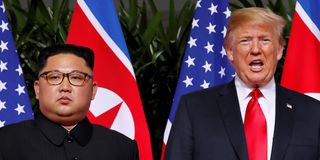To denuclearise N. Korea, Trump should think small

New Year’s traditions differ across the Pacific. Americans break out bottles of champagne and wake up with headaches and fuzzy memories. Koreans try to maintain sobriety in order to bow to family elders on Jan. 1 and receive blessings for the peace, prosperity, and health of their entire clan. Such cultural differences, as superficial as they might seem, might offer a lesson in foreign policy.
On New Year’s Day, North Korean leader Kim Jung Un addressed a very large political “family,” telling members that 2019 was “full of hope” and that all Koreans “should make greater strides in our efforts to boost inter-Korean relations, achieve peace and prosperity and reunify the country.” South Korean citizens, for the first time able to watch his annual address on television simultaneously with their northern kin, received a similarly optimistic message from their own president, Moon Jae-in, who promised in his national greeting: “I will make sure the peace will be irreversible.”
The coming year indeed promises continued warming of relations between the two Koreas and efforts to pave their own paths toward peaceful cooperation while US President Donald Trump tries to denuclearize Pyongyang on his own terms. However, the 2-1 lineup bodes ill for the Washington-Seoul alliance – currently under pressure over the expiry of the cost-sharing deal for the US troops stationed on the peninsula and concerns over a growing gap in North Korea policy – unless the Trump administration puts other items on the negotiating table. The White House also needs to work with Seoul on reconciliation and confidence-building measures in tandem with denuclearisation efforts.
Moon and Kim played the leading roles in last year’s diplomatic drama and will continue to direct attention-grabbing action, such as their three summits from April to September; demilitarization measures along the DMZ; military-to-military communication; establishment of a joint diplomatic liaison office in Kaesong, North Korea; breaking ground to connect railway and road networks; and preparing for another historical marker, Kim’s 2019 visit to Seoul, which Kim himself promised in his Dec. 30, 2018 personal letter to Moon.
In contrast, there has been no substantive progress on denuclearisation between Washington and Pyongyang since the Trump-Kim Singapore summit last July. Although Trump declared afterwards that North Korea was no longer a nuclear threat, the DPRK continued to produce fissile material and tested a new “ultramodern tactical weapon” in November. In his New Year’s speech, Kim called for an end to US-ROK joint military exercises, some of which Trump agreed to suspend to facilitate the inter-Korean summit, and called on Washington to “suspend” the positioning of “strategic assets from the outside.”
These two newly publicized demands, uttered publicly by Kim for the first time, are non-negotiables from the perspective of the US-ROK alliance.
It might be that Pyongyang is loading on demands in preparation for giving up some nuclear assets and information. On the other hand, it could mean that Kim has no intention of giving up the nuclear program but is trying to weaken the US-South Korean military alliance.
Washington might be able to break the current dispute with Pyongyang oversequencing the steps to denuclearisation – accounting for weapons, test sites, and verification versus sanctions relief and a “peace regime” – by offering to remove the THAAD (Terminal High Altitude Aerial Defence) antimissile batteries which the United States placed in South Korea in 2016 in spite of opposition from North Korea, China, and even its own allies in Seoul.
American troops and armaments, together with the highly competent South Korean military, are the bedrock of deterrence against any type of military adventurism, conventional and nuclear, by Pyongyang. Putting THAAD on the negotiating table would be a bold gesture by the United States toward constructive engagement, which much of the world – including South and North Korea – are seeking.
Even if all three parties want to continue diplomatic engagement and solve the nuclear standoff – still a big “if” even though Kim uttered “complete denuclearisation” as a national intention for the first time during his Jan. 1 broadcast – it is unclear whether the Trump White House would have the negotiators or the clarity of diplomatic vision to coordinate constructive strategies.
Another confidence-building move would be for the United States (and the United Nations Security Council) to facilitate the resumption of humanitarian aid funding and activities inside North Korea while preserving some of the hard-core sanctions, especially around dual use technologies and equipment that could be diverted for military use. Since 2018, many aid workers have been blocked by US measures from travelling to North Korea to provide help like medical and food assistance.




